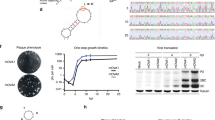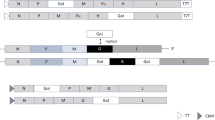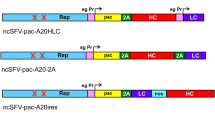Abstract
This paper describes the production of recombinant Semliki Forest virus encoding murine or human granulocyte–macrophage colony-stimulating factor (GM-CSF) and the capacity of these vectors to transduce murine and human tumor cells ex vivo. High-titer stocks (up to 3 × 109 particles/ml) of conditionally infective, replication-defective, recombinant SFV particles were generated using the SFV Helper-2 system. It is shown that the recombinant SFV/GM-CSF virus, as well as recombinant SFV carrying the β-galactosidase reporter gene, efficiently transduce both murine tumor cell lines as well as primary human renal carcinoma cells. Using ELISA's specific for GM-CSF, levels of GM-CSF production by the cells were determined. Levels of murine GM-CSF (mGM-CSF) produced by SFV/mGM-CSF transduced renal cell cancer cultures were equal to or higher than corresponding levels reported in the literature after transduction of similar renal carcinoma cell cultures using a retroviral vector system. The biological activity of GM-CSF was demonstrated by using cells which are dependent on GM-CSF for growth and by using primary bone marrow cells. All the transduced cell cultures (including the human renal cell carcinoma samples) produced GM-CSF for up to at least 4 days after transduction. The results imply that the recombinant SFV system can be used for rapid and facile preparation of autologous cancer cell vaccines.
This is a preview of subscription content, access via your institution
Access options
Subscribe to this journal
Receive 12 print issues and online access
$259.00 per year
only $21.58 per issue
Buy this article
- Purchase on Springer Link
- Instant access to full article PDF
Prices may be subject to local taxes which are calculated during checkout




Similar content being viewed by others
References
Simons JW et al. Bioactivity of autologous irradiated renal cell carcinoma vaccines generated by ex vivo granulocyte–macrophage colony-stimulating factor gene transfer Cancer Res 1997 57: 1537–1546
Abdel-Wahab Z et al. A phase I clinical trial of immunotherapy with interferon-gamma gene modified autologous melanoma cells: monitoring the humoral immune response Cancer 1997 80: 401–412
Lotze MT et al. Cytokine gene therapy of cancer using interleukin-12: murine and clinical trials Ann NY Acad Sci 1996 795: 440–454
Soiffer R et al. Vaccination with irradiated autologous melanoma cells engineered to secrete human granulocyte–macrophage colony-stimulating factor generates potent antitumor immunity in patients with metastatic melanoma Proc Natl Acad Sci USA 1998 95: 13141–13146
Chang AE et al. Immunogenetic therapy of human melanoma utilizing autologous tumor cells transduced to secrete granulocyte–macrophage colony-stimulating factor Hum Gene Ther 2000 11: 839–850
Mastrangelo MJ et al. Intratumoral recombinant GM-CSF-encoding virus as gene therapy in patients with cutaneous melanoma Cancer Gene Ther 1999 6: 409–422
Dranoff G et al. Vaccination with irradiated tumor cells engineered to secrete murine granulocyte–macrophage colony-stimulating factor stimulates potent, specific, and long-lasting anti-tumor immunity Proc Natl Acad Sci USA 1993 90: 3539–3543
Jaffee EM et al. High efficiency gene transfer into primary human tumor explants without cell selection Cancer Res 1993 53: 2221–2226
Sampson JH et al. Subcutaneous vaccination with irradiated, cytokine-producing tumor cells stimulates CD8(+) cell-mediated immunity against tumors located in the ‘immunologically privileged’ central nervous system Proc Natl Acad Sci USA 1996 93: 10399–10404
Yu JS, Burwick JA, Dranoff G, Breakafield XO . Gene therapy for metastatic brain tumors by vaccination with granulocyte–macrophage colony-stimulating factor-transduced tumor cells Hum Gene Ther 1997 8: 1065–1072
Simons JW et al. Induction of immunity to prostate cancer antigens: results of a clinical trial of vaccination with irradiated autologous prostate tumor cells engineered to secrete granulocyte–macrophage colony-stimulating factor using ex vivo gene transfer Cancer Res 1999 59: 5160–5168
Abe J et al. Antitumor effect induced by granulocyte/macrophage colony-stimulating factor gene-modified tumor vaccination: comparison of adenovirus- and retrovirus-mediated genetic transduction J Cancer Res Clin Oncol 1995 121: 587–592
Chen SH et al. Combination suicide and cytokine gene therapy for hepatic metastases of colon carcinoma: sustained antitumor immunity prolongs animal survival Cancer Res 1996 56: 3758–3762
Qin HX, Chatterjee SK . Construction of recombinant vaccinia virus expressing GM-CSF and its use as tumor vaccine Gene Therapy 1996 3: 59–66
Berglund P et al. Semliki Forest virus expression system: production of conditionally infectious recombinant particles Bio/Technology 1993 11: 916–920
Liljeström P, Garoff H . A new generation of animal cell expression vectors based on the Semliki Forest virus replicon Bio/Technology 1991 9: 1356–1361
Sjöberg EM, Suomalainen M, Garoff H . A significantly improved Semliki Forest virus expression system based on translation enhancer segments from the viral capsid gene Bio/Technology 1994 12: 1127–1131
Smerdou C, Liljeström P . Two-helper RNA system for production of recombinant Semliki Forest virus particles J Virol 1999 73: 1092–1098
Strauss JH, Strauss EG . The alphaviruses: gene expression, replication, and evolution Microbiol Rev 1994 58: 491–562
Griffin DE, Hardwick JM . Regulators on the road to persistent alphavirus infection Ann Rev Microbiol 1997 51: 565–592
Atkins GJ, Sheahan BJ, Liljestrom P . The molecular pathogenesis of Semliki Forest virus: a model virus made useful? J Gen Virol 1999 80: 2287–2297
Daemen T et al. Genetic immunization against cervical carcinoma:induction of cytotoxic T lymphocyte activity with a recombinant alphavirus vector expressing human papilomavirus type 16 E6 and E7 Gene Therapy 2000 7: 1859–1866
Zhou X et al. Generation of cytotoxic and humoral immune responses by non-replicative recombinant Semliki Forest virus Proc Natl Acad Sci USA 1995 92: 3009–3013
Fleeton M, Liljestrom P, Sheahan B, Atkins G . Recombinant Semliki Forest virus particles expressing louping ill virus antigen induce better protective response than plasmid-based DNA vaccines or an inactivated whole particle vaccine J Gen Virol 2000 81: 749–758
Calmenero P, Liljestrom P, Jondal M . Induction of P815 tumor immunity by recombinant Semliki Forest virus expressing the P1A gene Gene Therapy 1999 6: 1728–1733
Mossman SP et al. Protection against lethal simian immunodeficiency virus SIVsmmPBj14 disease by a recombinant Semliki Forest virus gp160 vaccine and by a gp120 subunit vaccine J Virol 1996 70: 1953–1960
Berglund P et al. Outcome of immunization of cynomolgus monkeys with recombinant Semliki Forest virus encoding human immunodeficiency virus type I envelope protein and challenge with a high dose of SHIV-4 virus Aids Res Hum Retrovir 1997 13: 1487–1495
Klimp AH et al. Effect of intraperitoneally administered recombinant murine granulocyte–macrophage colony-stimulating factor (rmGM-CSF) on the cytotoxic potential of murine peritoneal cells Br J Cancer 1999 79: 89–94
Klimp AH et al. Activation of peritoneal cells upon in vivo transfection with a recombinant alphavirus expressing GM-CSF Gene Therapy 2001 8: 300–307
Keith WN, Brown R, Pragnell IB . Retrovirus mediated transfer and expression of GM-CSF in haematopoietic cells Br J Cancer 1990 62: 388–394
Dranoff G . Strategies for cancer gene therapy Cancer Chemother Biol Respone Modif 1997 17: 328–348
Dranoff G . Interpreting cancer vaccine clinical trials J Gene Med 1999 1: 80–83
Jaffee EM . Immunotherapy of cancer Ann NY Acad Sci 1999 886: 67–72
Van Tendeloo VF, Van Broeckhoven C, Berneman ZN . Gene-based cancer vaccines: an ex vivo approach Leukemia 2001 15: 545–558
Esche C, Shurin MR, Lotze MT . The use of dendritic cells for cancer vaccination Curr Opin Mol Ther 1999 1: 72–81
Parmiani G, Rodolfo M, Melani C . Immunological gene therapy with ex vivo gene-modified tumor cells: a critique and a reappraisal Hum Gene Ther 2000 11: 1269–1275
Berns AJ et al. Phase I study of non-replicating autologous tumor cell injections using cells prepared with or without GM-CSF gene transduction in patients with metastatic renal cell carcinoma Hum Gene Ther 1995 6: 347–368
Zhang J et al. Cloning of human IL-12 p40 and p35 DNA into the Semliki Forest virus vector: expression of IL-12 in human tumor cells Gene Therapy 1997 4: 367–374
Asselin-Paturel C et al. Transfer of the murine interleukin-12 gene in vivo by a Semliki Forest virus vector induces B16 tumor regression through inhibition of tumor blood vessel formation monitored by Doppler ultrasonography Gene Therapy 1999 6: 606–615
Berglund P et al. Enhancing immune responses using suicidal DNA vaccines Nat Biotechnol 1998 16: 562–565
Glasgow GM, McGee MM, Sheahan BJ, Atkins GJ . Death mechanisms in cultured cells infected by Semliki Forest virus J Gen Virol 1997 78: 1559–1563
Ying H et al. Cancer therapy using a self-replicating RNA vaccine Nat Med 1999 5: 823–827
Leitner WW et al. Enhancement of tumor-specific immune response with plasmid DNA replicon vectors Cancer Res 2000 60: 51–55
Restifo NP, Ying H, Hwang L, Leitner WW . The promise of nucleic acid vaccines Gene Therapy 2000 7: 89–92
Morris-Downes MM et al. Semliki Forest virus-based vaccines: persistence, distribution and pathological analysis in two animal systems Vaccine 2001 19: 1978–1988
Schmidt W et al. Cancer vaccines: the interleukin 2 dosage effect Proc Natl Acad Sci USA 1995 92: 4711–4714
Bonnekoh B et al. Ex vivo and in vivo adenovirus-mediated gene therapy strategies induce a systemic anti-tumor immune defence in the B16 melanoma model J Invest Dermatol 1998 110: 867–871
Meanger J, Peroulis I, Mills J . Modified Semliki Forest virus expression vector that facilitates cloning BioTechniques 1997 23: 432–436
Peacock JH et al. Initial DNA damage or repair as the major determinant of cellular radiosensitivity? Int J Radiat Biol 1989 56: 543–547
Altman SW, Johnson GD, Prystowsky MB . Single proline substitutions in predicted α-helices of murine granulocyte–macrophage colony-stimulating factor result in a loss in bioactivity and altered glycosylation J Biol Chem 1991 266: 5333–5341
Shanafelt AB, Miyajima A, Kitamura T, Kastelein RA . The amino-terminal helix of GM-CSF and IL-5 governs high affinity binding to their receptors EMBO J 1991 10: 4105–4112
Durkin JP et al. The identification and characterization of a novel human differentiation-inhibiting protein that selectively blocks erythroid differentiation Blood 1992 5: 1161–1171
Acknowledgements
The authors would like to thank P Liljeström and P Berglund for expert advice and valuable suggestions. In addition, we thank A Heikema, R Timmer, M Esselink and J Bijzet for their assistance with cloning, preparation of SFV batches and performing ELISAs. This work was funded by a grant from the Dutch Cancer Foundation (NKB/KWF).
Author information
Authors and Affiliations
Rights and permissions
About this article
Cite this article
Withoff, S., Glazenburg, K., van Veen, M. et al. Replication-defective recombinant Semliki Forest virus encoding GM-CSF as a vector system for rapid and facile generation of autologous human tumor cell vaccines. Gene Ther 8, 1515–1523 (2001). https://doi.org/10.1038/sj.gt.3301556
Received:
Accepted:
Published:
Issue Date:
DOI: https://doi.org/10.1038/sj.gt.3301556



